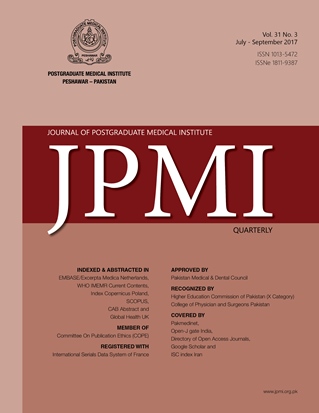COMPARISON OF EFFICACY AND POSTOPERATIVE COMPLICATIONS BETWEEN UNIPOLAR ELECTROCAUTERY AND BIPOLAR ELECTROCAUTERY IN CASES OF ANTERIOR EPISTAXIS: A RANDOMIZED CONTROL TRIAL
Main Article Content
Abstract
Objective: To compare the efficacy and post-operative complications between unipolar electrocautery and bipolar electrocautery in cases of anterior epistaxis.
Methodology: Total 60 patients fulfilling the inclusion criteria were selected from ENT outpatient department of CMH Bahawalpur from January 2016 to June 2016. The randomly divided patients of Group A (n=30) underwent cauterization with unipolar cautery while Group B (n=30) patients with bipolar cautery. Both procedures were compared in terms of efficacy (no re-bleed) and complications (post-operative pain, infection and septal perforation).
Results: The mean age of the participants was 26.35 ±13.3 years with 33 male and 27 female participants. No significant difference was noted in the post-operative bleeding after bipolar and unipolar procedure (p=0.313); showing both procedures to be equally effective. The groups were assessed for pain and infection on 1st and 5th postop day. Both the procedures had insignificant difference of pain on first postop day (p=0.07). However, there was significant difference of pain on 5th postop day (p=0.023). In Group A two cases developed postoperative infection compared to one case in Group B, but this difference
between both procedures was not significant (p=0.554). There was no septal perforation in both groups.
Conclusion: Unipolar and bipolar cautery procedures are equally effective in controlling epistaxis with almost negligible postoperative infection. As far as postoperative pain is considered, bipolar cautery is less painful procedure than unipolar cautery.
Methodology: Total 60 patients fulfilling the inclusion criteria were selected from ENT outpatient department of CMH Bahawalpur from January 2016 to June 2016. The randomly divided patients of Group A (n=30) underwent cauterization with unipolar cautery while Group B (n=30) patients with bipolar cautery. Both procedures were compared in terms of efficacy (no re-bleed) and complications (post-operative pain, infection and septal perforation).
Results: The mean age of the participants was 26.35 ±13.3 years with 33 male and 27 female participants. No significant difference was noted in the post-operative bleeding after bipolar and unipolar procedure (p=0.313); showing both procedures to be equally effective. The groups were assessed for pain and infection on 1st and 5th postop day. Both the procedures had insignificant difference of pain on first postop day (p=0.07). However, there was significant difference of pain on 5th postop day (p=0.023). In Group A two cases developed postoperative infection compared to one case in Group B, but this difference
between both procedures was not significant (p=0.554). There was no septal perforation in both groups.
Conclusion: Unipolar and bipolar cautery procedures are equally effective in controlling epistaxis with almost negligible postoperative infection. As far as postoperative pain is considered, bipolar cautery is less painful procedure than unipolar cautery.
Article Details
How to Cite
1.
Khan MA, Akram S, Khan M, Bin Usman H. COMPARISON OF EFFICACY AND POSTOPERATIVE COMPLICATIONS BETWEEN UNIPOLAR ELECTROCAUTERY AND BIPOLAR ELECTROCAUTERY IN CASES OF ANTERIOR EPISTAXIS: A RANDOMIZED CONTROL TRIAL. J Postgrad Med Inst [Internet]. 2017 Aug. 10 [cited 2025 Dec. 5];31(3). Available from: https://jpmi.org.pk/index.php/jpmi/article/view/2068
Issue
Section
Original Article
Work published in JPMI is licensed under a
Creative Commons Attribution-NonCommercial 2.0 Generic License.
Authors are permitted and encouraged to post their work online (e.g., in institutional repositories or on their website) prior to and during the submission process, as it can lead to productive exchanges, as well as earlier and greater citation of published work.


